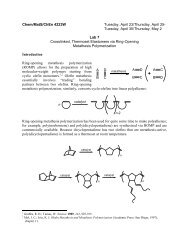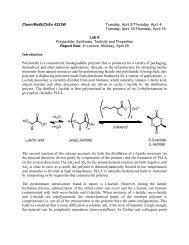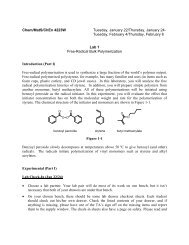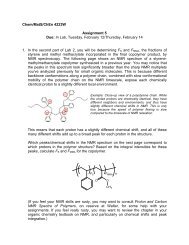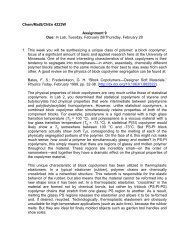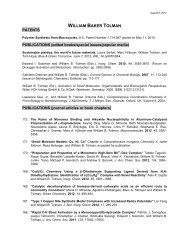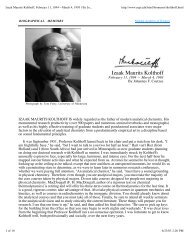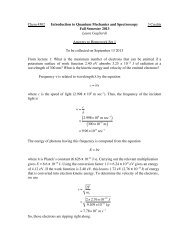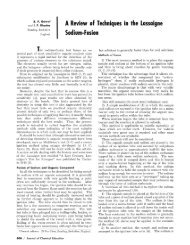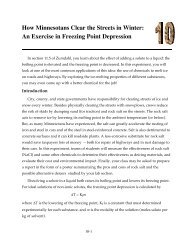ChemNews - Department of Chemistry - University of Minnesota
ChemNews - Department of Chemistry - University of Minnesota
ChemNews - Department of Chemistry - University of Minnesota
You also want an ePaper? Increase the reach of your titles
YUMPU automatically turns print PDFs into web optimized ePapers that Google loves.
RESEARCHInteraction <strong>of</strong> nanoparticles with biological cellsRecent research from the group <strong>of</strong> Pr<strong>of</strong>essor Christy HaynesNanoscale materials are facilitating novel biomedical applications in the areas <strong>of</strong> therapeutics and assay development.Characterizing the basic interaction <strong>of</strong> these nanoparticles with biological cells is critical for data interpretationand further technological development. This characterization <strong>of</strong> nanoparticle-cell interaction suffers froma paucity <strong>of</strong> analytical chemistry studies and presents interesting measurement challenges based on the complexbiological environment, the dynamic nature <strong>of</strong> the nanoparticle-cell interaction, and the high sensitivities requiredfor single cell assays.The Haynes group has recentlydemonstrated that carbon-fiber microelectrodeamperometry can be used toassess critical cellular function <strong>of</strong> primaryculture immune system cells afternanoparticle exposure. Gold nanoparticlesare the focus <strong>of</strong> Haynes groupstudies to date based on their wide applicationin the areas <strong>of</strong> DNA and drugdelivery, direct inhibition <strong>of</strong> cancer cell proliferation, photodynamic therapy, and as both intra- and extracellularbiomarker probes. The group’s electron microscopy and amperometry studies reveal that mast cells, a critical immunesystem effector cell, take up gold nanoparticles, these gold nanoparticles interrupt the granular matrix, andthe disrupted matrix triggers abnormal chemical messenger secretion. Understanding the mechanistic interaction<strong>of</strong> the nanoparticle and the intracellular environment will facilitate future design and fabrication <strong>of</strong> non-cytotoxicnanoscale materials.Fluidic and air-stable supported lipid bilayer and cellmimickingmicroarraysRecent research from the group <strong>of</strong> Pr<strong>of</strong>essor Xiaoyang ZhuAn academic-industrial research team led by Pr<strong>of</strong>essor Xiaoyang Zhu <strong>of</strong>UMN and Dr. Athena Guo <strong>of</strong> MicroSurfaces, Inc. reported a ground-breakingdiscovery on biomaterials and biotechnology in the latest issue <strong>of</strong> the Journal<strong>of</strong> the American Chemical Society (DOI:10.1021/ja800049f). The first authoron the paper was chemistry graduate student Yang Deng. As drug delivery,therapy, and medical imaging are becoming increasingly cell-specific, thereis a critical need for high fidelity and high-throughput screening methodsfor cell surface interactions. Cell membrane-mimicking surfaces, i.e., supportedlipid bilayers (SLBs), were not sufficiently robust to meet this need.Learning from nature, particular biophysics <strong>of</strong> the magic molecule cholesterol, this research team designed anddeveloped a novel surface with tethered and dispersed cholesterol groups. They discovered that SLBs formedon such a designer surface became air-stable due to the cooperative stabilizing effect <strong>of</strong> the tethered cholesterolgroups incorporated into the bottom leaflet. Achieving air-stability allowed the team to easily fabricate SLB microarraysfrom direct robotic spotting <strong>of</strong> vesicle solutions. They further demonstrated the application <strong>of</strong> the SLBsas cell membrane-mimicking microarrays by reconstituting peripheral as well as integral membrane componentsthat can be recognized by their respective targets. These demonstrations established the viability <strong>of</strong> the fluidic andair-stable SLB platform for generating content microarrays in high throughput studies, e.g., the screening <strong>of</strong> drugsand nanomedicine targeting cell surface receptors.Page 22



